University Research Report: E-Wallet Acceptance in Malaysia
VerifiedAdded on 2022/08/12
|6
|1058
|15
Report
AI Summary
This report examines the research methodology employed to study the acceptance of e-wallets in Malaysia. The study utilizes both primary and secondary research approaches to gather data. Primary research involves direct data collection from consumers through surveys and questionnaires, while secondary research leverages existing published sources like journals and reports. The report details the differences between these research types, outlining their respective advantages and disadvantages. It then presents a structured research process, comprising key stages such as defining research objectives, developing a research plan, designing data collection instruments, and analyzing the collected data. The report emphasizes the importance of each step in ensuring accurate and reliable research findings, including the careful wording of questions and the pre-testing of questionnaires. References to relevant academic sources are provided to support the methodological framework. The overall aim is to understand consumer perceptions and factors influencing the adoption of e-wallets in the Malaysian context.
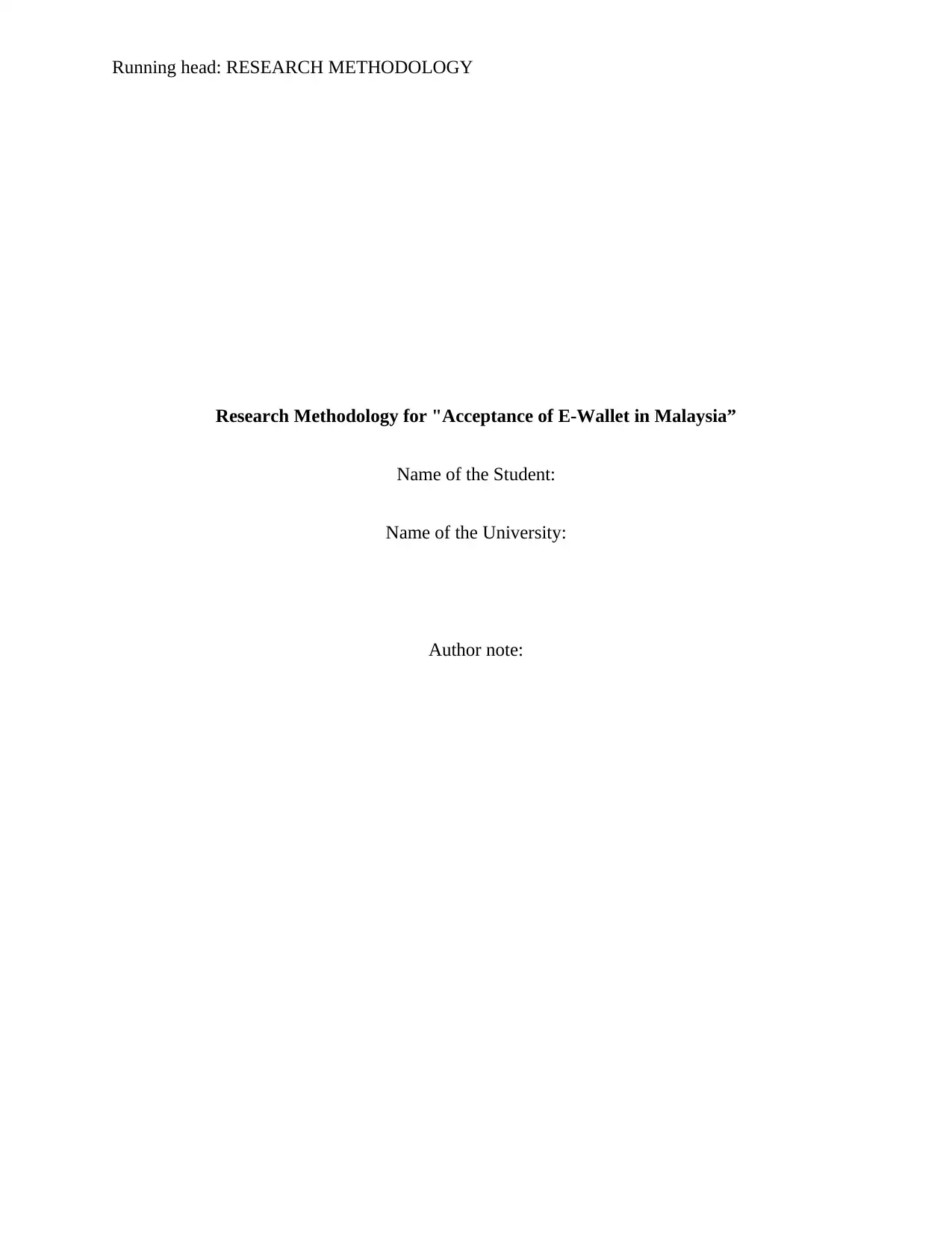
Running head: RESEARCH METHODOLOGY
Research Methodology for "Acceptance of E-Wallet in Malaysia”
Name of the Student:
Name of the University:
Author note:
Research Methodology for "Acceptance of E-Wallet in Malaysia”
Name of the Student:
Name of the University:
Author note:
Paraphrase This Document
Need a fresh take? Get an instant paraphrase of this document with our AI Paraphraser
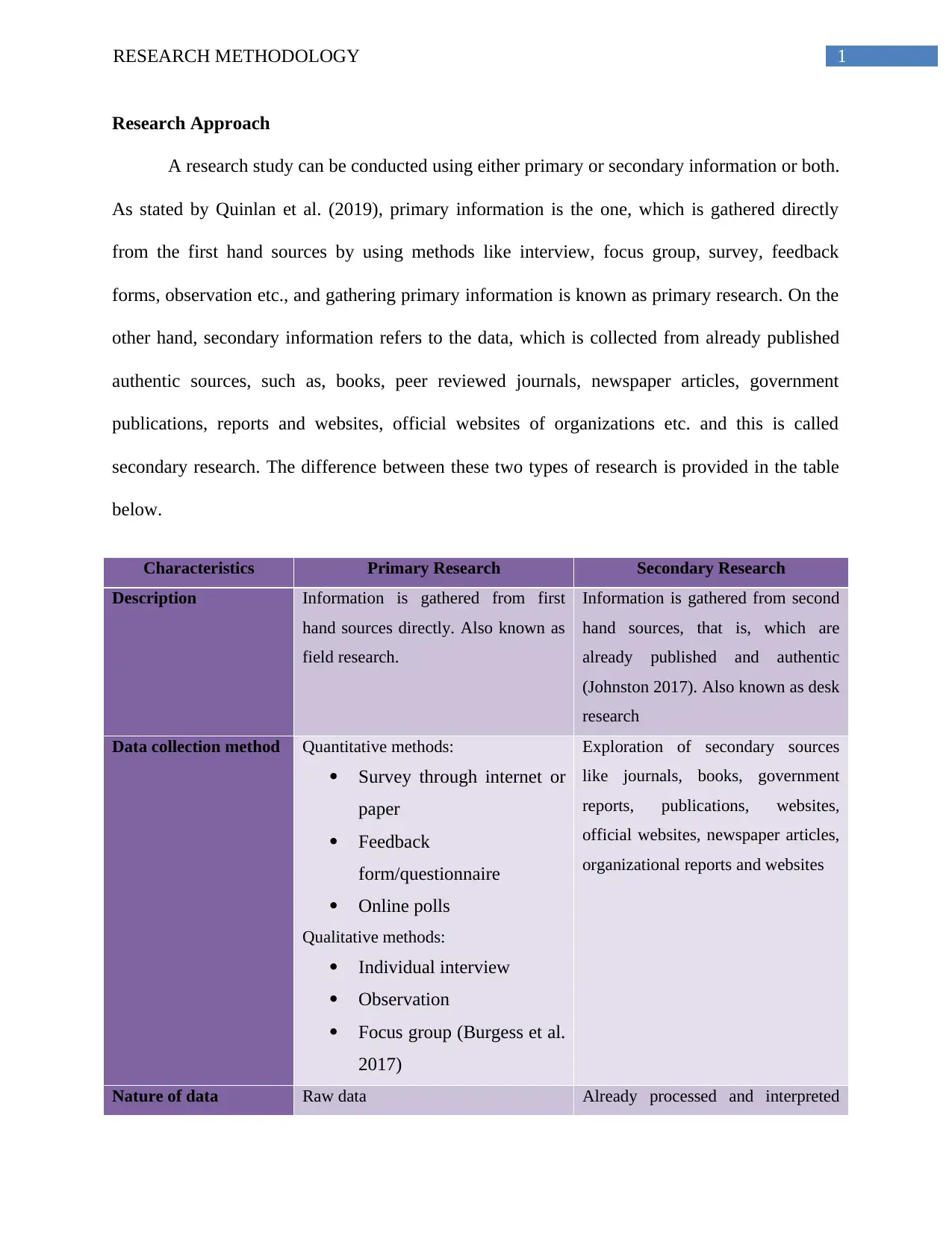
1RESEARCH METHODOLOGY
Research Approach
A research study can be conducted using either primary or secondary information or both.
As stated by Quinlan et al. (2019), primary information is the one, which is gathered directly
from the first hand sources by using methods like interview, focus group, survey, feedback
forms, observation etc., and gathering primary information is known as primary research. On the
other hand, secondary information refers to the data, which is collected from already published
authentic sources, such as, books, peer reviewed journals, newspaper articles, government
publications, reports and websites, official websites of organizations etc. and this is called
secondary research. The difference between these two types of research is provided in the table
below.
Characteristics Primary Research Secondary Research
Description Information is gathered from first
hand sources directly. Also known as
field research.
Information is gathered from second
hand sources, that is, which are
already published and authentic
(Johnston 2017). Also known as desk
research
Data collection method Quantitative methods:
Survey through internet or
paper
Feedback
form/questionnaire
Online polls
Qualitative methods:
Individual interview
Observation
Focus group (Burgess et al.
2017)
Exploration of secondary sources
like journals, books, government
reports, publications, websites,
official websites, newspaper articles,
organizational reports and websites
Nature of data Raw data Already processed and interpreted
Research Approach
A research study can be conducted using either primary or secondary information or both.
As stated by Quinlan et al. (2019), primary information is the one, which is gathered directly
from the first hand sources by using methods like interview, focus group, survey, feedback
forms, observation etc., and gathering primary information is known as primary research. On the
other hand, secondary information refers to the data, which is collected from already published
authentic sources, such as, books, peer reviewed journals, newspaper articles, government
publications, reports and websites, official websites of organizations etc. and this is called
secondary research. The difference between these two types of research is provided in the table
below.
Characteristics Primary Research Secondary Research
Description Information is gathered from first
hand sources directly. Also known as
field research.
Information is gathered from second
hand sources, that is, which are
already published and authentic
(Johnston 2017). Also known as desk
research
Data collection method Quantitative methods:
Survey through internet or
paper
Feedback
form/questionnaire
Online polls
Qualitative methods:
Individual interview
Observation
Focus group (Burgess et al.
2017)
Exploration of secondary sources
like journals, books, government
reports, publications, websites,
official websites, newspaper articles,
organizational reports and websites
Nature of data Raw data Already processed and interpreted
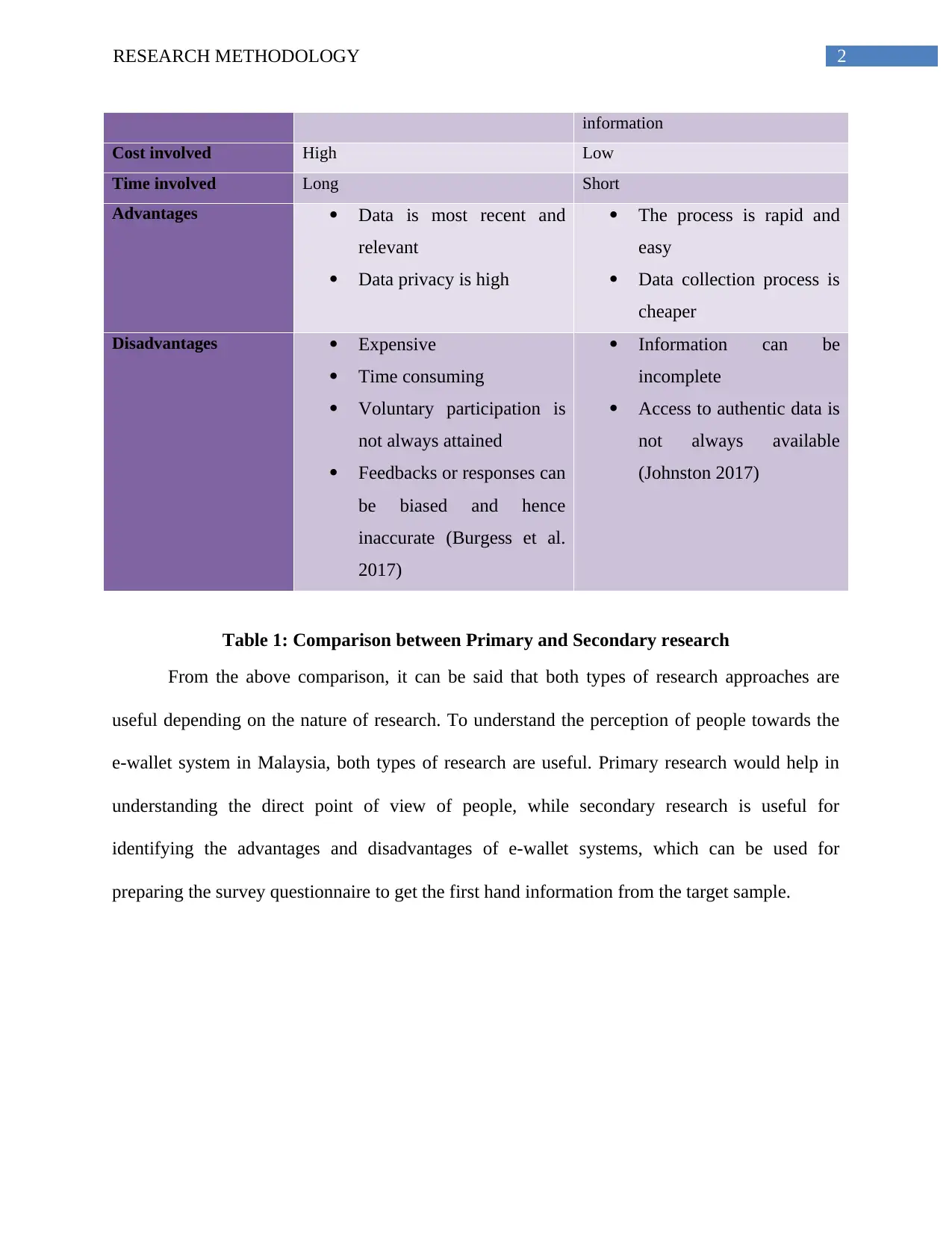
2RESEARCH METHODOLOGY
information
Cost involved High Low
Time involved Long Short
Advantages Data is most recent and
relevant
Data privacy is high
The process is rapid and
easy
Data collection process is
cheaper
Disadvantages Expensive
Time consuming
Voluntary participation is
not always attained
Feedbacks or responses can
be biased and hence
inaccurate (Burgess et al.
2017)
Information can be
incomplete
Access to authentic data is
not always available
(Johnston 2017)
Table 1: Comparison between Primary and Secondary research
From the above comparison, it can be said that both types of research approaches are
useful depending on the nature of research. To understand the perception of people towards the
e-wallet system in Malaysia, both types of research are useful. Primary research would help in
understanding the direct point of view of people, while secondary research is useful for
identifying the advantages and disadvantages of e-wallet systems, which can be used for
preparing the survey questionnaire to get the first hand information from the target sample.
information
Cost involved High Low
Time involved Long Short
Advantages Data is most recent and
relevant
Data privacy is high
The process is rapid and
easy
Data collection process is
cheaper
Disadvantages Expensive
Time consuming
Voluntary participation is
not always attained
Feedbacks or responses can
be biased and hence
inaccurate (Burgess et al.
2017)
Information can be
incomplete
Access to authentic data is
not always available
(Johnston 2017)
Table 1: Comparison between Primary and Secondary research
From the above comparison, it can be said that both types of research approaches are
useful depending on the nature of research. To understand the perception of people towards the
e-wallet system in Malaysia, both types of research are useful. Primary research would help in
understanding the direct point of view of people, while secondary research is useful for
identifying the advantages and disadvantages of e-wallet systems, which can be used for
preparing the survey questionnaire to get the first hand information from the target sample.
⊘ This is a preview!⊘
Do you want full access?
Subscribe today to unlock all pages.

Trusted by 1+ million students worldwide
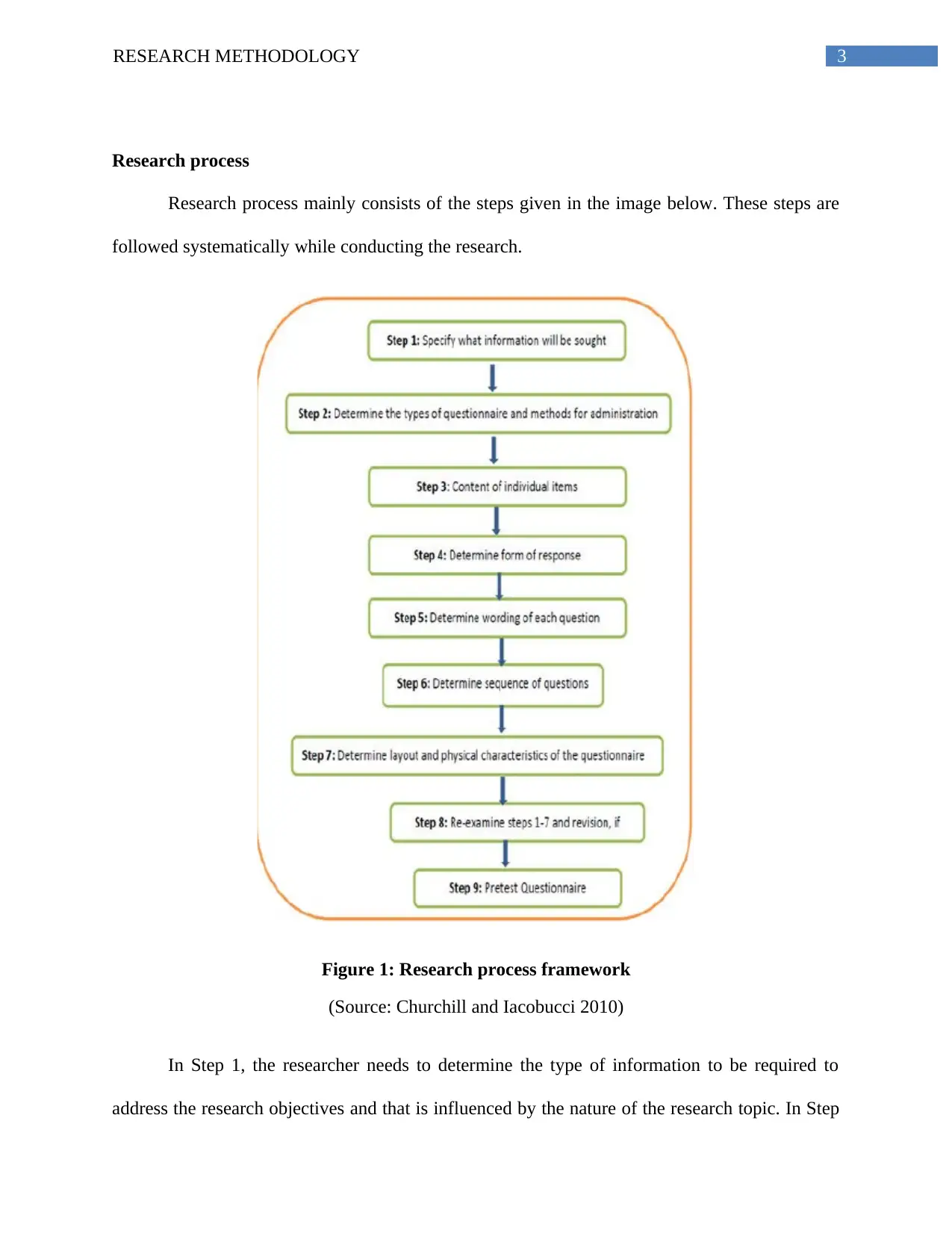
3RESEARCH METHODOLOGY
Research process
Research process mainly consists of the steps given in the image below. These steps are
followed systematically while conducting the research.
Figure 1: Research process framework
(Source: Churchill and Iacobucci 2010)
In Step 1, the researcher needs to determine the type of information to be required to
address the research objectives and that is influenced by the nature of the research topic. In Step
Research process
Research process mainly consists of the steps given in the image below. These steps are
followed systematically while conducting the research.
Figure 1: Research process framework
(Source: Churchill and Iacobucci 2010)
In Step 1, the researcher needs to determine the type of information to be required to
address the research objectives and that is influenced by the nature of the research topic. In Step
Paraphrase This Document
Need a fresh take? Get an instant paraphrase of this document with our AI Paraphraser
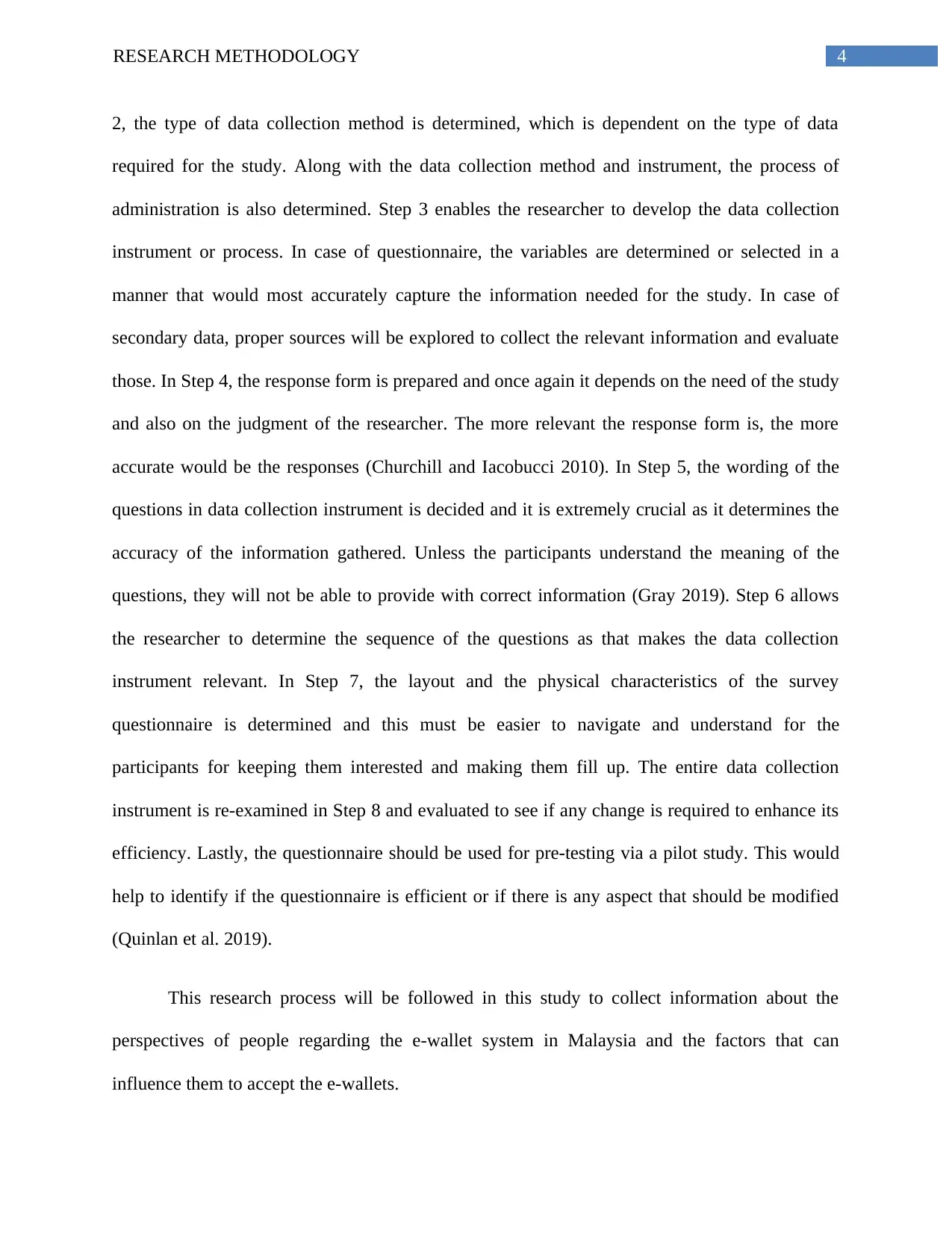
4RESEARCH METHODOLOGY
2, the type of data collection method is determined, which is dependent on the type of data
required for the study. Along with the data collection method and instrument, the process of
administration is also determined. Step 3 enables the researcher to develop the data collection
instrument or process. In case of questionnaire, the variables are determined or selected in a
manner that would most accurately capture the information needed for the study. In case of
secondary data, proper sources will be explored to collect the relevant information and evaluate
those. In Step 4, the response form is prepared and once again it depends on the need of the study
and also on the judgment of the researcher. The more relevant the response form is, the more
accurate would be the responses (Churchill and Iacobucci 2010). In Step 5, the wording of the
questions in data collection instrument is decided and it is extremely crucial as it determines the
accuracy of the information gathered. Unless the participants understand the meaning of the
questions, they will not be able to provide with correct information (Gray 2019). Step 6 allows
the researcher to determine the sequence of the questions as that makes the data collection
instrument relevant. In Step 7, the layout and the physical characteristics of the survey
questionnaire is determined and this must be easier to navigate and understand for the
participants for keeping them interested and making them fill up. The entire data collection
instrument is re-examined in Step 8 and evaluated to see if any change is required to enhance its
efficiency. Lastly, the questionnaire should be used for pre-testing via a pilot study. This would
help to identify if the questionnaire is efficient or if there is any aspect that should be modified
(Quinlan et al. 2019).
This research process will be followed in this study to collect information about the
perspectives of people regarding the e-wallet system in Malaysia and the factors that can
influence them to accept the e-wallets.
2, the type of data collection method is determined, which is dependent on the type of data
required for the study. Along with the data collection method and instrument, the process of
administration is also determined. Step 3 enables the researcher to develop the data collection
instrument or process. In case of questionnaire, the variables are determined or selected in a
manner that would most accurately capture the information needed for the study. In case of
secondary data, proper sources will be explored to collect the relevant information and evaluate
those. In Step 4, the response form is prepared and once again it depends on the need of the study
and also on the judgment of the researcher. The more relevant the response form is, the more
accurate would be the responses (Churchill and Iacobucci 2010). In Step 5, the wording of the
questions in data collection instrument is decided and it is extremely crucial as it determines the
accuracy of the information gathered. Unless the participants understand the meaning of the
questions, they will not be able to provide with correct information (Gray 2019). Step 6 allows
the researcher to determine the sequence of the questions as that makes the data collection
instrument relevant. In Step 7, the layout and the physical characteristics of the survey
questionnaire is determined and this must be easier to navigate and understand for the
participants for keeping them interested and making them fill up. The entire data collection
instrument is re-examined in Step 8 and evaluated to see if any change is required to enhance its
efficiency. Lastly, the questionnaire should be used for pre-testing via a pilot study. This would
help to identify if the questionnaire is efficient or if there is any aspect that should be modified
(Quinlan et al. 2019).
This research process will be followed in this study to collect information about the
perspectives of people regarding the e-wallet system in Malaysia and the factors that can
influence them to accept the e-wallets.
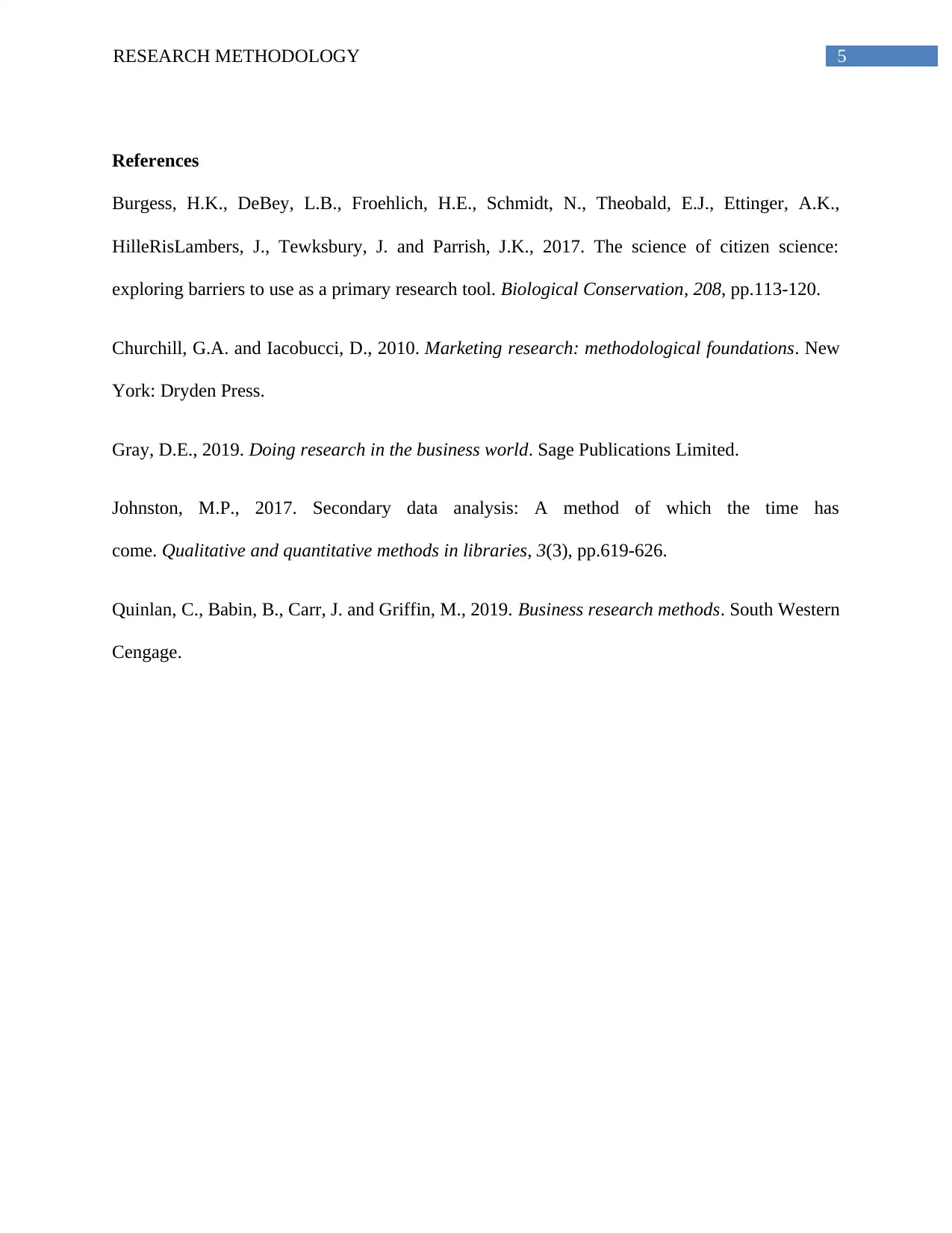
5RESEARCH METHODOLOGY
References
Burgess, H.K., DeBey, L.B., Froehlich, H.E., Schmidt, N., Theobald, E.J., Ettinger, A.K.,
HilleRisLambers, J., Tewksbury, J. and Parrish, J.K., 2017. The science of citizen science:
exploring barriers to use as a primary research tool. Biological Conservation, 208, pp.113-120.
Churchill, G.A. and Iacobucci, D., 2010. Marketing research: methodological foundations. New
York: Dryden Press.
Gray, D.E., 2019. Doing research in the business world. Sage Publications Limited.
Johnston, M.P., 2017. Secondary data analysis: A method of which the time has
come. Qualitative and quantitative methods in libraries, 3(3), pp.619-626.
Quinlan, C., Babin, B., Carr, J. and Griffin, M., 2019. Business research methods. South Western
Cengage.
References
Burgess, H.K., DeBey, L.B., Froehlich, H.E., Schmidt, N., Theobald, E.J., Ettinger, A.K.,
HilleRisLambers, J., Tewksbury, J. and Parrish, J.K., 2017. The science of citizen science:
exploring barriers to use as a primary research tool. Biological Conservation, 208, pp.113-120.
Churchill, G.A. and Iacobucci, D., 2010. Marketing research: methodological foundations. New
York: Dryden Press.
Gray, D.E., 2019. Doing research in the business world. Sage Publications Limited.
Johnston, M.P., 2017. Secondary data analysis: A method of which the time has
come. Qualitative and quantitative methods in libraries, 3(3), pp.619-626.
Quinlan, C., Babin, B., Carr, J. and Griffin, M., 2019. Business research methods. South Western
Cengage.
⊘ This is a preview!⊘
Do you want full access?
Subscribe today to unlock all pages.

Trusted by 1+ million students worldwide
1 out of 6
Related Documents
Your All-in-One AI-Powered Toolkit for Academic Success.
+13062052269
info@desklib.com
Available 24*7 on WhatsApp / Email
![[object Object]](/_next/static/media/star-bottom.7253800d.svg)
Unlock your academic potential
Copyright © 2020–2025 A2Z Services. All Rights Reserved. Developed and managed by ZUCOL.




